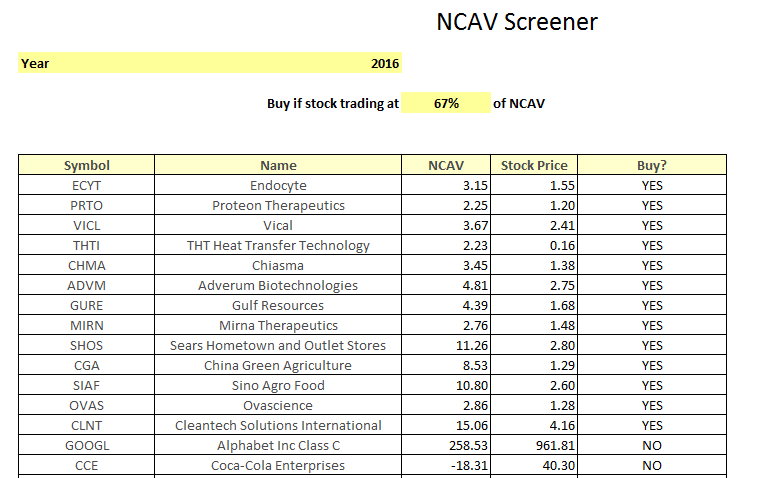Ncav Screener


Investors are always looking for ways to identify deep value stocks and their are many investment philosophies to help them with their goals. Among them, one of the most famous models of value investing is the Benjamin Graham NCAV Screener. Benjamin Graham is considered to be the father of value investing and is the author of one of the most respected books on value investing – ‘The Intelligent Investor’. In this article we will learn about what NCAV is and how we can build an NCAV screener to screen stocks.
Download NCAV Stock Screener to use with MarketXLS
What is NCAV?
NCAV refers to the Net Current Asset Value. The NCAV per Share is calculated as the balance sheet current assets minus all the firm’s (current and long-term) liabilities divided by the number of shares outstanding. The common definition of NCAV is:
NCAV = Current Assets – [Total Liabilities + Preferred Stock]
The current assets primarily consist of cash and cash equivalents, account receivables, and inventories. These are assets that are highly liquid, and are either already cash or could be converted into cash in a short period of time.
Graham also suggests that preferred stock be considered on the liability side of the balance sheet, not as part of capital and surplus.
Note that net current assets are different from working capital. Working capital is current assets minus current liabilities and focus only on the current parts of the balance sheet. Whereas to calculate net current assets you deduct total liabilities for current assets. It’s an extremely rigorous measure.
NCAV & Market Value
Graham’s philosophy behind NCAV approach was that when the stocks traded at a price below their NCAV per share, it means that they are actually trading below their liquidating value. We can reasonably assume that most of these companies can be sold off for atleast the value of these assets. Apart from this we can expect that the company’s remaining assets to be sold and converted into cash. This includes assets like such as plant, property, and equipment.
Graham explains his approach to identifying a bargain issue in his book “The
Intelligent Investor:
“To be as concrete as possible, let us suggest that an issue is not a true ‘bargain’ unless the indicated value [NCAV] is at least 50 percent more than the price.”
He further explains this while comparing stock price and company’s net current asset value:
“…if a common stock can be bought at no more than two-thirds of the working-capital alone—disregarding all other assets—and if the earnings record and prospects are reasonably satisfactory, there is strong reason to believe that the investor is getting substantially more than his money’s worth.”
NCAV Screener
Now that we know how to buy stocks based on NCAV, let us look at how to find these stocks. The best way to do this is to build a stock screener that calculates the companies’ NCAV per share. And then compares it with their market price. Then it shortlists the stocks that are trading at a discount to the companies NCAV per share. To buy, the stock should be trading at atleast one-third below NCAV.
Here are the steps to screen stocks based on NCAV:
- Universe of Stocks. There are no specific restrictions, however, investors generally use this screener for small-cap and even micro-cap stocks.
- Get the current stock price of each of these stocks.
- Calculate the NCAV per share of each stock.
- Primary selection criteria – Bargain price with a margin of safety. Price should be no more than two-thirds the company’s net current asset value. [Price <= ⅔ NCAV]
NCAV Screener in Excel Using MarketXLS
We have created a NCAV screener template that downloads the latest list of the S&P500 stocks, calculates the NCAV per Share for each stock, gets their trading price and then filters the stocks based on the NCAV bargain buying approach. You will need a licensed copy of MarketXLS to use the template.

I invite you to book a demo with me or my team to save time, enhance your investment research, and streamline your workflows.